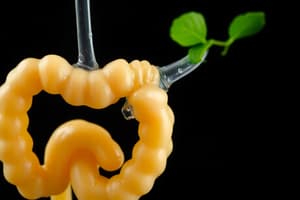Podcast
Questions and Answers
What initiates carbohydrate digestion before food enters the mouth?
What initiates carbohydrate digestion before food enters the mouth?
- Taste of food
- Food temperature
- Sight and smell of food (correct)
- Electric signals
What enzyme is contained in saliva that converts starch into oligosaccharides?
What enzyme is contained in saliva that converts starch into oligosaccharides?
Salivary Amylase
Swallowing is only an involuntary process.
Swallowing is only an involuntary process.
False (B)
What happens to salivary amylase in the stomach?
What happens to salivary amylase in the stomach?
What regulates the release of the acid chime out of the stomach?
What regulates the release of the acid chime out of the stomach?
Excess release of acid chime would _______ the tissue of the duodenum.
Excess release of acid chime would _______ the tissue of the duodenum.
What hormone is released in response to acid chime in the duodenum?
What hormone is released in response to acid chime in the duodenum?
What stimulates the secretion of pancreatic amylase?
What stimulates the secretion of pancreatic amylase?
The brush boarder enzymes are released by the pancreas.
The brush boarder enzymes are released by the pancreas.
What is the function of glucoamylase and dextranase?
What is the function of glucoamylase and dextranase?
What molecules does sucrase cleave sucrose into?
What molecules does sucrase cleave sucrose into?
What does lactase primarily break down?
What does lactase primarily break down?
Where are glucose, fructose, and galactose absorbed into after digestion?
Where are glucose, fructose, and galactose absorbed into after digestion?
What does the liver convert fructose and galactose into?
What does the liver convert fructose and galactose into?
Glycogen is stored as quick energy in the form of a _______ molecule.
Glycogen is stored as quick energy in the form of a _______ molecule.
What determines the solubility of glucose in water inside cells?
What determines the solubility of glucose in water inside cells?
The process of creating ATP involves the hydrolysis of glycogen.
The process of creating ATP involves the hydrolysis of glycogen.
Study Notes
Carbohydrate Digestion Steps
- Digestion begins with the sight and smell of food, stimulating saliva release from salivary glands.
- Teeth masticate food and the tongue forms it into a bolus with saliva.
Saliva's Role
- Saliva contains salivary amylase, an enzyme that converts starch into oligosaccharides.
- Due to brief residence in the mouth, not all starch is broken down; amylase does not work on disaccharides or monosaccharides.
Swallowing Process
- Swallowing is both voluntary (tongue manipulation) and involuntary (once food touches the uvula).
- Peristalsis moves food down the esophagus with wave-like muscle contractions.
Stomach Functionality
- Strong stomach acid denatures salivary amylase, halting carbohydrate digestion.
- The stomach's role is to churn food into chyme, an acid paste.
Regulation of Chyme Release
- Pyloric valve regulates release of chyme into the duodenum, preventing excess acid flow.
Consequences of Excess Acid
- Over-release of acid could denature enzymes in the duodenum, risking damage to its tissues due to insufficient mucus.
Hormonal Responses to Chyme
- Acid chyme triggers receptor cells in the duodenum to release Secretin.
- Secretin stimulates the pancreas to release bicarbonate ions, neutralizing chyme acidity.
Enzymatic Activation
- Once acidity is neutralized, pancreatic enzymes can digest nutrients.
- Fats and proteins in chyme cause the secretion of cholecystokinin, prompting pancreatic amylase release.
Role of Pancreatic Amylase
- Pancreatic amylase acts on starches, breaking them into oligosaccharides.
- Muscle contractions move oligosaccharides through the jejunum and into the ileum.
Brush Border Enzymes
- Submucosa layer of villi in the ileum releases enzymes to further digest carbohydrates.
Microvilli Structure
- Absorptive columnar cells have microvilli forming the brush border.
- Brush border enzymes include glucoamylase, dextranase, intestinal maltase, sucrase, and lactase.
Enzyme Specificity
- Glucoamylase and dextranase cleave oligosaccharides into disaccharides.
- Sucrase converts sucrose into glucose and fructose.
- Maltase breaks maltose into two glucose molecules.
- Lactase splits lactose into glucose and galactose.
Absorption into Bloodstream
- Glucose, fructose, and galactose are small enough to enter the bloodstream, reaching the liver.
- Liver converts fructose and galactose into glucose for energy storage.
Glycogen Storage
- Glycogen serves as a quick energy reserve, formed from glucose via dehydration synthesis.
- Branching in glycogen structure allows rapid ATP production through respiration.
Energy Reserve Locations
- Muscle and liver cells store large amounts of glycogen, the body’s primary energy reserve.
ATP Production
- Branching in glycogen allows for efficient hydrolysis of glucose for ATP creation.
Studying That Suits You
Use AI to generate personalized quizzes and flashcards to suit your learning preferences.
Description
Explore the essential steps involved in carbohydrate digestion with these informative flashcards. Learn how the process begins even before food reaches the mouth, and the role of enzymes in breaking down starches. Perfect for anyone studying human digestion and nutritional science.



